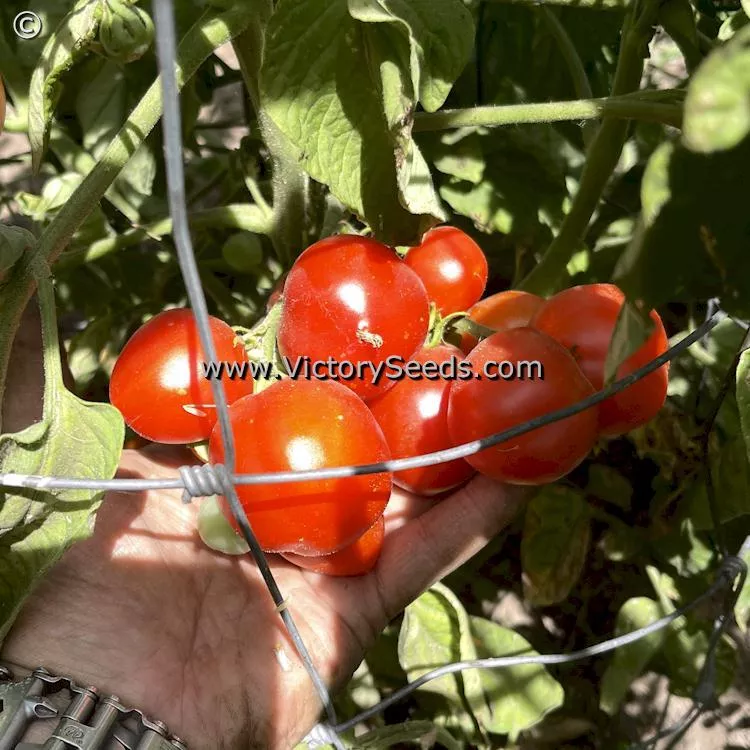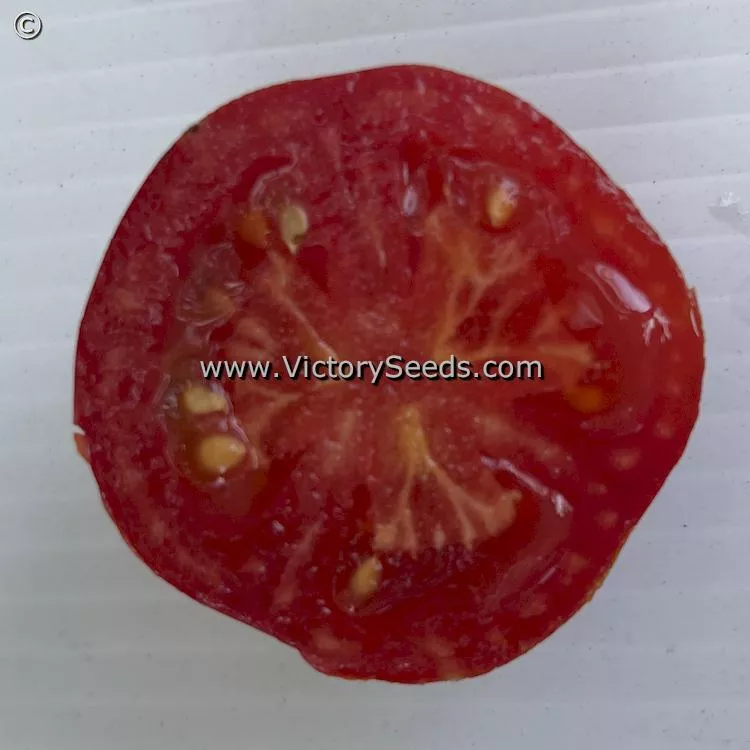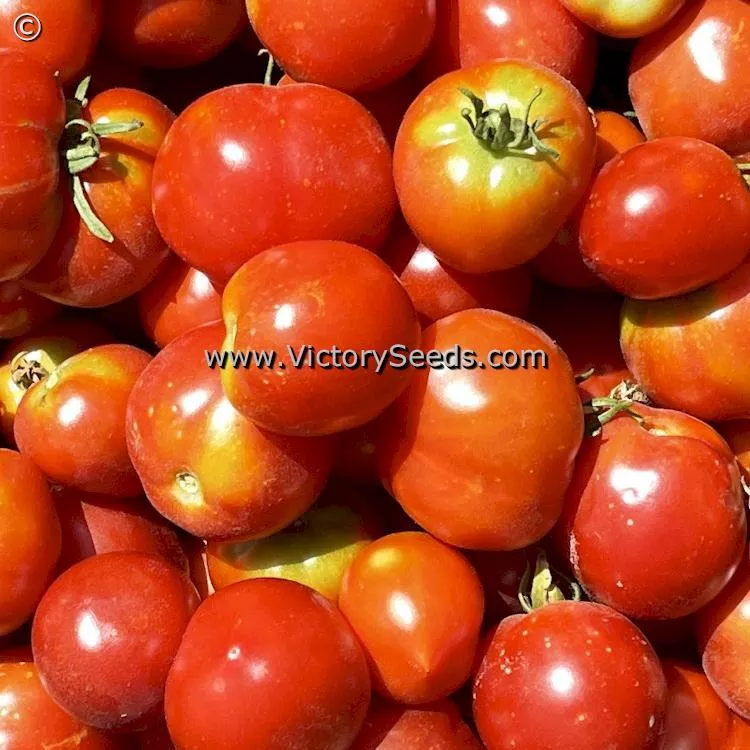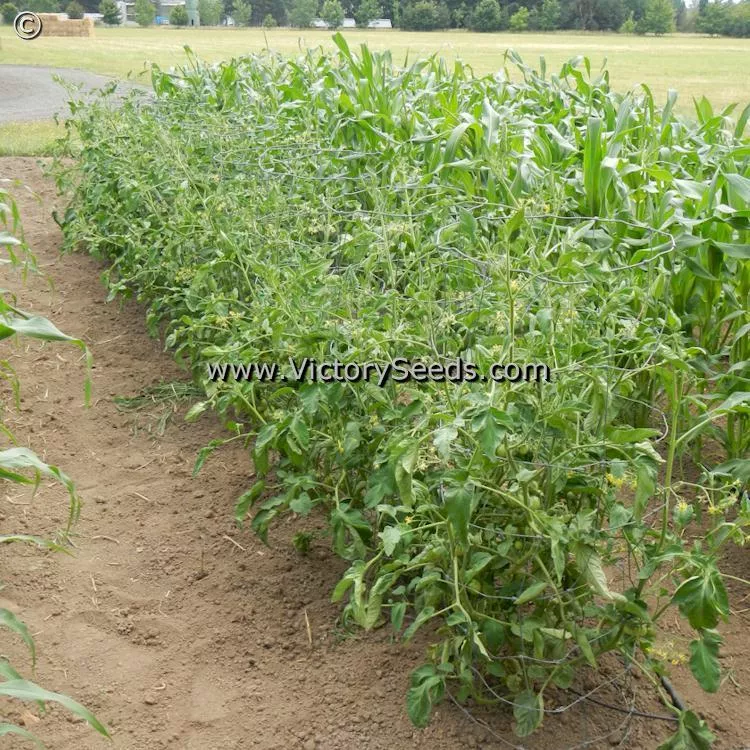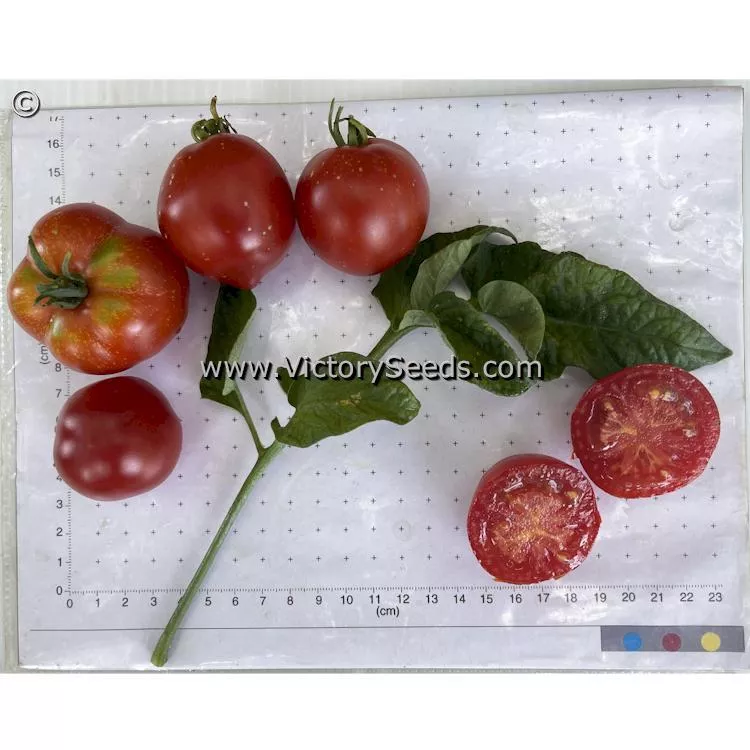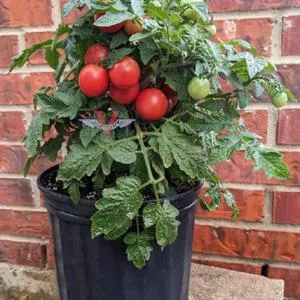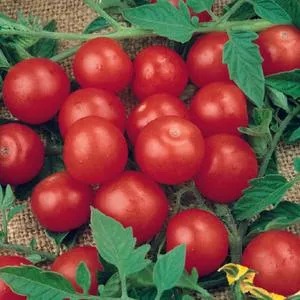






Stephania Heritage Tomato
Solanum lycopersicum
Price: $3.45
SKU: 340539165 days, indeterminate - The extremely productive, potato leaf plants of 'Stephania Heritage' are relatively compact for an indeterminate tomato, and they do benefit from support. Its fruit are a small saladette-type, two to four ounces each, red in color, and have a nice, old-fashioned, mildly sweet flavor. Interestingly, as they develop, they tend to have a "tip" on the blossom end that disappears as the fruit matures and fills out into a more globe shape.
In early 2021, we received a handwritten letter from a gardener named Stephania Janovec Potter, with an accompanying sample of tomato seeds. She described that they were a cherished family heirloom variety, which she hoped we would work to help to keep from disappearing.[1] She went on to give an exceptionally detailed history of variety, its description, its amazing attributes, and because of all this, we fit it into our already full grow-out plan ... and we are so glad that we did!
Not only was all of the information that she shared with us accurate, we found an interesting trait that was not documented. In the summer of 2021, our area experienced a "heat dome," the likes of which had never been experience here. Very early in the summer, when typical average temperatures are in the low 70ºs, we had multiple days above 100ºF. These heat records came at the most inopportune time for us as the majority of the tomato plants in our fields were in full bloom. This heat killed pollen, blossoms dropped, and it ultimately drastically reduced our yields. There were a couple of exceptions, but 'Stephania Heritage' stood out. Its yields were spectacular and it was seemingly unaffected by the heat!
'Stephania Heritage' began in the early 1970s when Stephania's mother, Martha Janovec, received seeds from local Skamania County (Washington) Extension Agent Dick Adlard.[2] He explained that the tomato had originated in the high altitudes of the Chilean Andes and that they would be well-suited for the colder, shorter growing season of the Columbia River Gorge region. Multiple family grew the varieties over the decades, in various locations in Washington State. Although the family had several names for the tomato, it was named 'Stephania Heritage' by Clark County (Washington) Master Gardener and local "tomato guy," Al Pavelko, whom Stephania had given seeds to in the 2010s.
In early 2021, we received a handwritten letter from a gardener named Stephania Janovec Potter, with an accompanying sample of tomato seeds. She described that they were a cherished family heirloom variety, which she hoped we would work to help to keep from disappearing.[1] She went on to give an exceptionally detailed history of variety, its description, its amazing attributes, and because of all this, we fit it into our already full grow-out plan ... and we are so glad that we did!
Not only was all of the information that she shared with us accurate, we found an interesting trait that was not documented. In the summer of 2021, our area experienced a "heat dome," the likes of which had never been experience here. Very early in the summer, when typical average temperatures are in the low 70ºs, we had multiple days above 100ºF. These heat records came at the most inopportune time for us as the majority of the tomato plants in our fields were in full bloom. This heat killed pollen, blossoms dropped, and it ultimately drastically reduced our yields. There were a couple of exceptions, but 'Stephania Heritage' stood out. Its yields were spectacular and it was seemingly unaffected by the heat!
'Stephania Heritage' began in the early 1970s when Stephania's mother, Martha Janovec, received seeds from local Skamania County (Washington) Extension Agent Dick Adlard.[2] He explained that the tomato had originated in the high altitudes of the Chilean Andes and that they would be well-suited for the colder, shorter growing season of the Columbia River Gorge region. Multiple family grew the varieties over the decades, in various locations in Washington State. Although the family had several names for the tomato, it was named 'Stephania Heritage' by Clark County (Washington) Master Gardener and local "tomato guy," Al Pavelko, whom Stephania had given seeds to in the 2010s.
Tomato Uses: Small Fruits / Salads
Fruit Color: Red
Harvest Timing: Early/Short Season
Genetic Classification: Open Pollinated
Fruit Color: Red
Harvest Timing: Early/Short Season
Genetic Classification: Open Pollinated
Stephania told us that her family called the variety "toMayto" because May is when they, "... start eating them."
To accomplish this in her garden, which was located at a 1,500 foot elevation in the generally harsh conditions of the Columbia River Gorge, she explained how she starts her seeds in cells just before Christmas every year, later transferring them to four inch pots. In late February or early March, she moves the plants to soil-filled totes outdoors on the south side of her home, keeping them covered until April. By doing this, she is able to begin enjoying fruit in May.
To accomplish this in her garden, which was located at a 1,500 foot elevation in the generally harsh conditions of the Columbia River Gorge, she explained how she starts her seeds in cells just before Christmas every year, later transferring them to four inch pots. In late February or early March, she moves the plants to soil-filled totes outdoors on the south side of her home, keeping them covered until April. By doing this, she is able to begin enjoying fruit in May.
Informational References:
- Correspondence from Stephania Janovec Potter, January 12, 2021.
- Biography of Richard "Dick" Adlard.
- "Heritage Tomato Named After Gardener," Farm Show Magazine, Volume 40, Issue 2, Page 21, 2016.
Notes:
In her letter to us, Stephania mentioned that the seed may have been originally been a wild variety, a selection of a wild variety, or otherwise connected to a variety called 'Imura Prior Beta'. We could find to documentation to support this. Furthermore, we could find no information about a variety by that name. We did, however, find some interesting circumstantial information regarding varieties with similar spellings, origin stories, and descriptions. These include:
- Immun Prior Beta - This variety was mentioned in the "Tomato Genetic Cooperative" journal, Vol. 11, Feb 1960. Also listed in the USDA's Genebank as PI 401737 as 'Immun Prior Beta II', a determinate from Central Bohemia, Czech Republic. It may be a parent on 'Stupice' which share similar characteristics with 'Stephania Heritage'.
- 'Imun Prior Beta' - Listed in the USDA's Genebank as PI 451959, an indeterminate from Norway.
- Immur Prior Beta - This variety was mentioned in the "Tomato Genetic Cooperative" journal, Vol. 10, March, 1960.
- 'Imur Prior Beta' described as being developed in Norway for short seasons and high altitudes and was mentioned in the following publications:
- First listed in the "1979 Seed Savers Exchange Yearbook" by Gladys Gronke, Chicago, Illinois.
- Lowden's Better Plants and Seeds of Ancaster, Ontario, Canada, operated by then 89 year old seedsman Edward Loden, introduced the 'Imur Prior Beta' in his 1980 seed catalog. He noted that it was a tomato developed in Norway which is also used extensively for canning in the high altitude regions of the Andes Mountains in Chile. He hoped that it would be widely tested. He also listed it in the "1981 Seed Savers Exchange Yearbook."
- Immuna Prior Beta was mentioned in the following publications:
- Oregon Vegetable Digest, January, 1967, Volume 16, Number 1 and Oregon Vegetable Digest, January, 1969, Volume 18, Number 1, described Immuna Prior Beta as an indeterminate, small-fruited variety, "with an unusual ability to set fruit at low temperatures."
- "Market & Home Garden Vegetable Varieties," Cooperative Extension of Oregon State University, Circular EC671, June, 1971, Listed as an "Early Indeterminate (vinging)" tomato variety.
- Oregon Vegetable Digest, January, 1975, Volume 24, Number 1 and Oregon Vegetable Digest, January, 1977, Volume 26, Number 1, describe it as "Early Determinate."
- Oregon Vegetable Digest, October, 1981, Volume 30, Number 4, describe it as "An indeterminate variety with a sprawling plant. The first ripening date is quite early, but the total crop of 2-inch fruits matures slowly."
- Mentioned in the "Tomato Genetic Cooperative" journal, Vol. 33, 1983, where it was described as one parent in a complex cross that led to the creation of 'Oregon 11' by Oregon State University.
Customer Reviews:
Do you have experience with this one? 📝 📣 Write a review!
No reviews have been posted yet.

